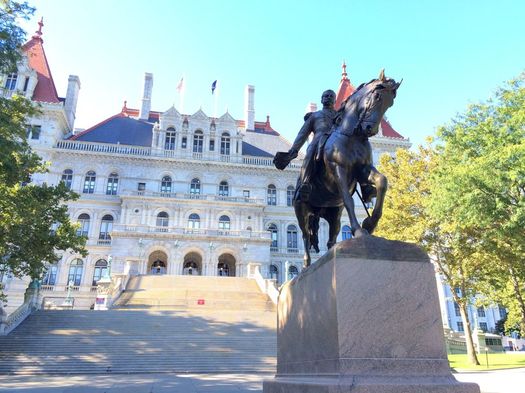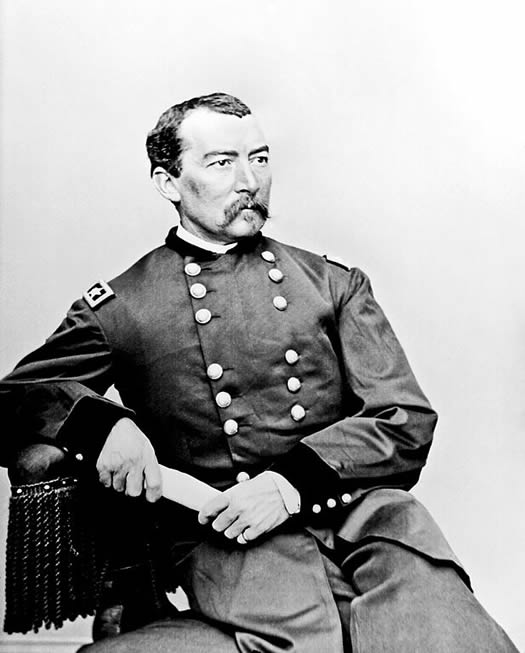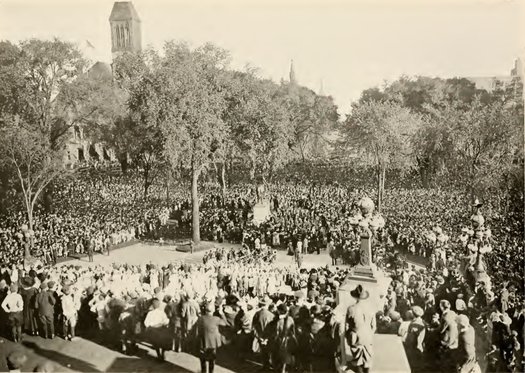10 facts about Philip Sheridan, whose statue has stood in front of the state Capitol for 100 years

You know, this statue.
One hundred years ago today, on October 7, 1916, the statue that stands in front of the state Capitol was unveiled. The monument honors Philip Sheridan, one of the most famous Union generals of the Civil War -- and an Albany native (maybe, probably).
We suspect if you stopped the many people passing by the statue each day in downtown Albany, few would be able to tell you much about Sheridan. It's just one of the many monuments that dot the city. But the unveiling of the sculpture was a big event a century ago.
So, who was Sheridan? Well, like a lot of historical figures, he's considered a great hero -- and a villain -- depending on the context.
He was from Albany -- unless he wasn't
Sheridan said he was born in Albany in 1831, the son of Irish immigrants, on the street that now bears his name. (It was called Fox Street at the time.) His family would move to Ohio not long after that, and it was there that he'd grow up.
Despite Sheridan's claim of being an Albany native by birth, there's long been suspicion that he wasn't actually born here, but actually in Ireland (or, at least, on the way from Ireland). As one version of the story went, when Sheridan's parents showed up in Albany they had a two-week-old infant with them -- and that was Philip Sheridan.
The question became of particular interest in 1884 when there was talk of the Republicans potentially nominating him for the presidency.
He was short
Sheridan stood five feet-five inches and was nicknamed "Little Phil." His height prompted Abraham Lincoln to tease him after one of Sheridan's successful campaigns during the Civil War: "General Sheridan, when this peculiar war began I thought a cavalryman should be at least six feet four inches high, but I have changed my mind. Five feet four will do in a pinch."

A photo portrait of Sheridan from the 1860s by Matthew Brady. / photo via Wikipedia
He was a key general for the Union Army
Sheridan started his military career in the Pacific Northwest, and wasn't a major figure in the Union army at the start of the Civil War. He was transferred to posts in the Midwest and worked his way up the ranks, eventually becoming commander of a cavalry unit. And it was in that role that he would start to gain fame in the army. He eventually became a key subordinate of Ulysses S. Grant.
At Grant's direction, Sheridan led a scorched-earth campaign against the Confederate army in the Shenandoah Valley in an attempt to wipe out the entire base of support for the opposing army. It was a tactic that would later be made (in)famous during Sherman's March to the Sea.
Sheridan's troops would also pursue Robert E. Lee leading up to the surrender at Appomattox.
He became famous, in part, because of a poem
During that campaign in the Shenandoah Valley in 1864, Sheridan's army was the subject of a surprise attack by Confederate forces -- while Sheridan was away from his troops. Sheridan heard the artillery and raced to the battle, rallied his troops, and his forces won the day -- a victory that would lead to the collapse of the Confederate army in that area.
Sheridan got a letter of thanks from Lincoln. And Thomas Buchanan Read wrote a poem about Sheridan -- "Sheridan's Ride." A clip:
The first that the general saw were the groups
Of stragglers, and then the retreating troops;
What was done? what to do? a glance told him both,
Then, striking his spurs, with a terrible oath,
He dashed down the line 'mid a storm of huzzas,
And the wave of retreat checked its course there, because
The sight of the master compelled it to pause.
With foam and with dust the black charger was gray;
By the flash of his eye, and the red nostril's play,
He seemed to the whole great army to say,
"I have brought you Sheridan all the way
From Winchester, down to save the day!"
The poem would make Sheridan -- and his horse -- famous. In fact, Sheridan changed the name of his horse to "Winchester" because of the episode.
His horse was stuffed
About that horse: He was stuffed and mounted after he died in 1878, and presented to Sheridan. The horse is now in the collection of the Smithsonian's National Museum of American History.
He wasn't a fan of Texas
After the Civil War, Sheridan was dispatched to oversee Reconstruction in Texas and Louisiana. He's credited with being an opponent of corruption during that time, and stirred things up by dismissing the governor of Texas. He ended up being removed by President Andrew Johnson, who reportedly told Ulysses Grant that Sheridan's term had "been one of absolute tyranny."
Sheridan apparently didn't leave there as a fan of Texas. He reportedly commented of the place: "If I owned Texas and Hell, I would rent Texas and live in Hell."
He oversaw brutal campaigns against Native Americans -- and bison
Sheridan's post-Civil War career also included overseeing the army's campaign against various Native American tribes throughout the territories of the west. And Sheridan employed the same brutal scorched-earth tactics he had used during the Civil War while showing little interest in protecting non-combatants who happened to get in the way.
It was during this time that Sheridan is reported to have made the infamous statement "the only good Indians I ever saw were dead" -- though Sheridan denied he said it.
Another casualty of Sheridan's time overseeing the campaigns against Native Americans: bison. As part of the effort to undercut the various Native American tribes, Sheridan urged the widespread hunting of the animals. As he said of hunters brought in to take out the herds: "[F]or a lasting peace, let them kill, skin and sell until the buffaloes are exterminated."
His influence helped Yellowstone become a national park
Sheridan ended up being a key proponent of the protection of Yellowstone in the 1870s and 1880s. He even at one point directed a cavalry unit to take control of the land in order to protect it from development. A mountain peak there was named in his honor.
He was (briefly) the military ruler of Chicago
The post from which Sheridan oversaw the forces in the Great Plains was Chicago (because it was a major railroad intersection). And he there was during the "Great Chicago Fire" of 1871. He led troops to dynamite buildings in the path of the fire in order to block the fire's advance and ended up briefly being the ruler of the city when martial law was instituted following the fire.

The scene at the unveiling in 1916.
The unveiling of his statue in Albany drew a huge crowd
Sheridan died in 1888, and three decades later a movement started in New York to erect a statue honoring him. Apparently Ohio had taken the lead in claiming the famous general as its own, and New York wanted to get in on the action.
New York's governor, Martin Glynn, publicly started off the campaign, and called for the people of Albany to raise $10,000 for the monument. If the city could do that, he'd get the state legislature to put up $20,000. As Glynn said at the time: "State pride and local pride demand that this be done."
In the fall of 1916 the monument -- designed by sculptor John Quincy Adams Ward, and finished by Daniel Chester French -- was ready to be installed. And on October 7, there was a parade for the unveiling. Albany mayor John Stevens even declared a half-day holiday so people could attend the ceremony. A big crowd -- described as "a mighty throng" -- turned out to see a series of officials and guests of honor make speeches before the statue was revealed.
As Stevens said that day: "I do not possess the eloquence to do so, nor is it my function to speak of the great military genius, the great services rendered to the nation by General Sheridan. This will be dwelt upon by the eminent speakers whom I shall have the honor to introduce. My only desire is to express the appreciation of all concerned for this beautiful memorial -- dedicated to the memory of Gen. Philip H. Sheridan, in the city of his birth."
Hi there. Comments have been closed for this item. Still have something to say? Contact us.
Comments
Philip Sheridan's desk can still be found at North Bend, the Virginia home that served as his headquarters for a time during the Civil War. Today North Bend Plantation is a wonderful bed-and-breakfast (see http://www.northbendplantation.com). It wasn't until I stayed there that I learned about Sheridan's connection to Albany!
... said Ellen on Oct 7, 2016 at 5:48 PM | link
I am offended that this statue representing a man who participated in the genocide of Southerners and Native Americans sits on public land. Take it down.
... said CMouse on Oct 7, 2016 at 6:26 PM | link
Sheridan was a great commander, rising to command a Corps in the Army of the Potomac by 1865. Grant considered him his best subordinate commander.
It's too bad most people in Albany have no idea who he was. Good for you AOA.
... said Stan on Oct 8, 2016 at 9:05 AM | link
This monument should be taken down because it is a symbol of racism, hate, genocide, and crimes against humanity against Native Americans. It is an embarrassment to the state of New York.
... said John Femia on Jan 18, 2018 at 6:47 PM | link